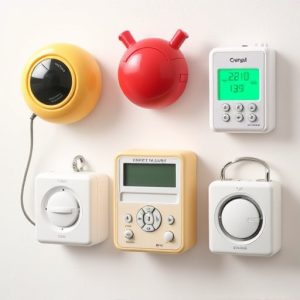Lone Worker Safety: Personal Attack Alarms & Sound Range
Working alone poses significant safety risks, highlighting the need for robust measures like the Per…….
Working alone poses significant safety risks, highlighting the need for robust measures like the Personal Attack Alarm (PAA). With a sound range up to 800 meters and distinct signals, PAAs ensure prompt assistance in remote areas. These devices, coupled with training on alarm activation and de-escalation techniques, are crucial for lone workers' security, especially in high-noise environments where traditional alarms might be ineffective.
In today’s diverse workplace, lone workers face unique challenges. Understanding the risks associated with working alone is paramount for ensuring safety. This article delves into crucial aspects of safety alert systems, specifically focusing on personal attack alarms and their critical role in enhancing protection. We explore how sound range influences device effectiveness, different types available, and essential implementation strategies for prompt response. By understanding these key elements, organizations can better safeguard their lone workers.
- Understanding the Risks of Lone Working
- The Importance of Personal Attack Alarms
- How Sound Range Plays a Critical Role
- Types of Personal Attack Alarm Devices
- Implementing and Training for Effective Response
Understanding the Risks of Lone Working
Working alone can present unique challenges and potential risks for employees, making it essential to have robust safety measures in place. One critical aspect is recognizing the hazards associated with lone working and ensuring an effective communication system. When an individual is isolated, there is a reduced chance of immediate assistance in case of an emergency or an accident. This is where safety alert systems come into play, providing a lifeline for these workers.
A Personal Attack Alarm (PAA) is a vital tool to enhance the safety of lone workers. It is designed to emit a distinct sound within a specific range, alerting others when the wearer encounters distress. The alarm’s sound can travel up to 800 meters in ideal conditions, ensuring that help arrives promptly. This simple yet powerful device gives workers confidence, knowing they have a means to signal for assistance if needed, especially in remote or isolated work environments.
The Importance of Personal Attack Alarms
Lone workers often face unique challenges when it comes to safety, especially in remote or isolated environments. In such situations, a Personal Attack Alarm (PAA) can be a lifesaver. These devices are designed to provide an easy and immediate way for workers to signal distress quickly, even if they’re unable to make a call or send a message.
The effectiveness of a PAA lies in its sound range and distinct alarm signals. A good quality personal attack alarm should have a sufficient sound range, allowing it to be heard over distances, should the wearer need to attract attention urgently. The alarm sound itself should be designed to break through background noise, ensuring that help can be summoned promptly. This critical feature of personal attack alarms makes them essential tools for lone workers, providing them with a powerful means of communication in emergencies.
How Sound Range Plays a Critical Role
In the context of lone worker safety, the sound range of a Personal Attack Alarm (PAA) is a critical component that can make all the difference in an emergency situation. The ability to communicate distress signals over distance ensures that help arrives promptly, which can be a matter of life and death. A well-designed PAA should offer a substantial sound range, enabling workers to signal for assistance even if they are far from their base or colleagues.
This range is particularly vital in varied environments, such as outdoor sites, remote locations, or industrial complexes where background noise levels can be high. Advanced PAAs utilize sophisticated audio technology to cut through these noises, ensuring the alarm is heard clearly and effectively. The sound range not only facilitates timely rescue but also reinforces a sense of security among lone workers, knowing that their distress signals will be noticed and acted upon quickly.
Types of Personal Attack Alarm Devices
Personal attack alarm devices are a crucial component of safety alert systems for lone workers, designed to provide immediate assistance in case of distress. These devices typically include various features such as loud personal attack alarm sounds and GPS tracking capabilities. The Personal Attack Alarm Sound Range varies among models, but most are designed to be heard from distances ranging from 50 to 100 meters, ensuring that help can be summoned even in remote locations.
There are several types of personal attack alarms available, each with unique features. Some devices feature a simple button that triggers an alarm sound when pressed, while others have automatic fall detection and motion sensors that activate the alarm upon detecting unexpected movement or a fall. Advanced models may also incorporate Bluetooth connectivity, allowing users to connect to mobile apps for real-time tracking and communication with monitoring centers.
Implementing and Training for Effective Response
Implementing an effective safety alert system requires careful consideration and strategic placement. Devices like Personal Attack Alarms should be easily accessible and visible, with a distinct sound range audible in various environments. Training is paramount; workers must understand how to activate the alarm during emergencies, especially when a personal attack occurs. This includes teaching them to recognize distress signals and respond promptly.
Regular drills and simulations can enhance preparedness. Employees should practice using the alarms under scenarios mimicking potential threats, ensuring they can operate the device correctly and efficiently. Moreover, training should cover de-escalation techniques, encouraging workers to avoid confrontations whenever possible while still knowing how to trigger an alarm for immediate assistance if needed.
Lone workers face unique challenges, but by understanding these risks and implementing effective safety alert systems, such as personal attack alarms with sufficient sound range, we can significantly enhance their protection. Choosing the right device, combined with thorough training, ensures a swift and effective response in emergency situations. This proactive approach is vital for fostering a safer working environment for those who operate independently.


